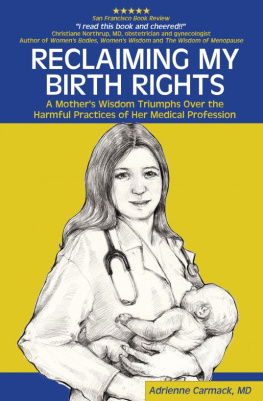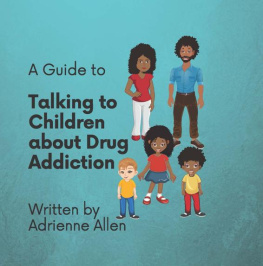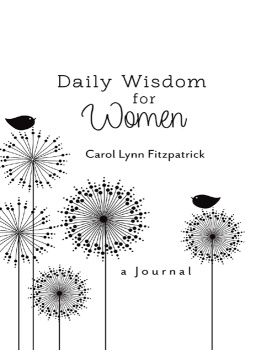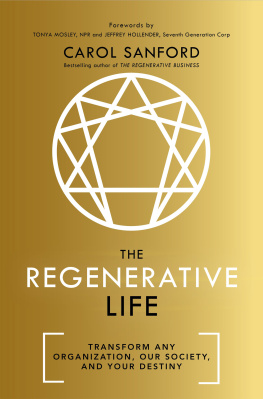WHEN LIFE CHANGES
OR
YOU WISH IT WOULD
A Guide to Finding Your Next Step
Despite Fear, Obstacles, or Confusion

Carol Adrienne, Ph.D.

Contents
LIFE is not quite the same as it was. But then, it never really is. The pace of change does seem to be picking up. Like it or not, our lives are externally affected by technology, innovations, political decisions, the weather, and millions of daily events that take place in the world without our knowledge. The effort to control our lives in the face of unrelenting change and increasing uncertainty is often overwhelming. We run but can we keep up? We want to adapt and thrive, but dont always know what is expected of us. We want to do more than survive, we want to thrive. We want to fulfill the purpose we know (or hope) lives within us. We want to discover that purpose so that we can make a contribution. We want to be happy.
Living in the twenty-first century requires that we be masters of change.
When Life Changes or You Wish It Would is a handbook that shows both how to handle change and how to create change, so that you can become who you are meant to beeven though the journey must take you into uncharted territory. The premise of the book is that your unfolding life purpose is a navigating force that is always taking you where you need to go. Your job is to pay attention to the message in the changes that occur to you and to respond from your true self. In mythic terms this is the heros (and heroines) journey.
As a human being, you are unique because your life evolvesthrough daily change and daily choices. You grow because of how you handle these various and often profoundly challenging experiences. Your inborn talents and desires, which strive to be expressed as your life purpose, continually create new conditions for growth. However, if this movement forward is based on intentions, motivations, or choices made from your false and ego-centered self, you will create change for the wrong reasons. If we have not taken the time to examine ourselves and what is right for us, we find that we are still living according to beliefs that may not hold much interest to us anymore. These beliefs tell us that the only way to be a good personthe only way to receive love and respectis to please others rather than to become who we were meant to be.
Everyone wants to be loved and recognized for his or her uniqueness. Everyone wants to make a contribution to life. On the one hand, we want new life but, on the other hand, we often resist going into uncharted territory. Instead of being happy and excited about change, all too often we face the unknown with fear, trepidation, and resistance. When Life Changes expresses the view that by expanding our spiritual connection, developing a stronger sense of self, and staying awake to the purposeful movement of change in our lives, we will be more able to handle whatever we face.
To live successfully on our growing edge, we must be willing to do four things: (1) commit to being true to our inner integrity; (2) shed our need to overcontrol; (3) act on what has heart and meaning; and (4) trust that there are no accidents. By reclaiming our inner guidance and taking action on what we value, we begin to bloom in our own right. Experiences of success and increased self-esteem allow us to face the unknown with more trust and resourcefulness.
As you read on, you will be reminded of some of the most enduring and supportive spiritual teachings of the ages. You will be offered practical methods for changing your life for the better, and you will be introduced to others just like yourself who are enjoying traveling into the unknown.
Please note that most names in the stories have been changed to ensure privacy.
To capture insights and track your own life changes, you might find it useful to start a life changes journal, where you can allow thoughts to flow freely and keep a record of your intentions, intuitions, and directional signals.
THE CALL
WHILE I was working on the outline for this book, my friend Jaye Oliver, who lives in Santa Fe, New Mexico, suggested we swap houses for a couple of weeks. At first I said no, thinking that this would be too much of a disruption to my writing. She persisted, though, and I realized that getting away from my daily routine might be a good idea. I agreed but immediately felt a mixture of guilt, pleasant anticipation, and apprehension that I might get lonely by myself for two weeks. I called another friend, Zenobia Barlow, who agreed with delight to accompany me, along with her partner, James Tyler. As it turned out, the retreat from routine was exactly what I needed to catalyze my thinking about this book.
After several days of visiting places of beauty and serenity, and playing and photographing in the beautiful landscape of New Mexico, Zenobia and I found ourselves on the sunny back porch of our temporary home avidly discussing life change. Working collaboratively has always been inspirational for me, and suddenly ideas, which had been germinating in the darkin my procrastinating voidbegan to take a more coherent form. Out of our dialogue grew the Map of Change (page 12) and a new format for my stories.
GERMINATION TIME
A FEW months earlier I had visited the Metropolitan Museum of Art in New York to see the portrait paintings of Jean-Auguste-Dominique Ingres, the French painter who lived and worked around the time of Napoleon. I remember being struck by the description of one of his most famous portraits of an aristocratic beauty. The description mentioned that the germination time for this piece had been twelve years. The idea of a necessary germination time on a creative project struck me anew. I have come to trust that, when a piece of information stands out like that, it is somehow important to my own work and life.
I have always been the type of person who moves ahead with a project fairly quickly. However, this book seemed to resist my normal speed. Of course, I thought, this must be my fault. I should get more disciplined. I should just sit down and start writing. Those internal voices of duty, criticism, and urgency began to get louder. Yet I could not do more than rewrite a few of my interviews. The idea that there is a germination time for things let me off my own hook. I had not been honoring the process that was unfolding within me. Evidently the unknown of the finished book was not yet ready to be known.
TIMING
AS SOON as Zenobia and I roughed out the map of changes, I could see clearly the path for the rest of the book. But this was not to be the end of what needed to happen in Santa Fe.
The day after Zenobia and James left, I had another visitor, a mutual friend of Jayes and mine, Justine Toms. Justine had left her car at Jayes house a few days before and came by to retrieve it. Many of you may know Justines name from the radio program New Dimensions, which she cofounded and produces with her husband, Michael Toms, the shows host. Justines arrival and our discussion now seem like divine serendipity. Her unexpected visit showed me once again that our projects are always nourished by the larger ground of synchronicity and purposeful timing. At the time I merely thought of her arrival as a pleasant opportunity to chat over a cup of tea.















